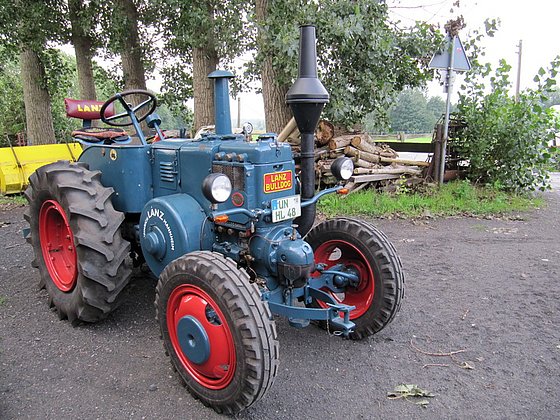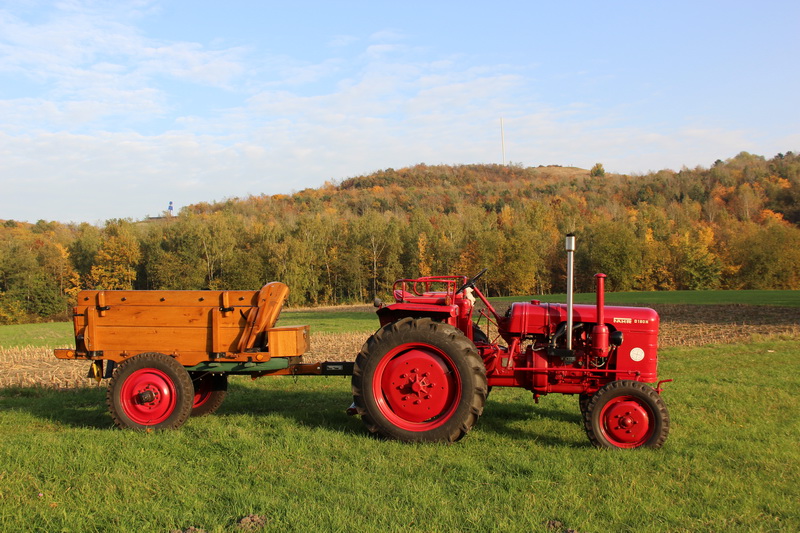
The birth of the tractor
Hermann Arens / Former employee in the Building Safety Department
and Environmental Management
Photo: Private
When a bulldog gave its name to the first tractor
Hermann Arens, a long-time employee in the Department of Building, Safety and Environmental Management at the University of Wuppertal, on the first tractor with a hot-bulb engine
In 1921, the Heinrich Lanz Mannheim company presented the prototype of a 12 hp crude oil tractor with a hot-bulb engine, At the Leipzig Agricultural Exhibition. It was the Lanz HL, developed by Fritz Huber. This presentation is considered the birth of the tractor. What made the vehicle, which resembled a bulldog in appearance and was given the name Lanz Bulldog, so special?
Arens: The peculiar shape of the exposed cylinder and the hot-bulb, slightly reminiscent of the appearance of a bulldog's head, with its two ocular vent holes.
All future Lanz tractors kept this name as their brand name.
But the technology presented revolutionised agriculture. Just as all previous agricultural machines were huge unwieldy monsters (locomobiles) and were driven by expensively generated steam.
The work was made easier and cheaper for the farmers due to the change from steam to internal combustion engines with simple, robust technology in a convenient shape.
With a cubic capacity of 6220 cc, the single-cylinder hot-bulb engine was installed on a chassis. Thus, it was a self-propelled and steerable machine which, once started, ran all day and could be used very flexibly.

Lanz Bulldog 7506 out of the year 1935
A special feature of the Lanz HL (HL stands for Dr. Fritz Huber/Lanz) was the so-called multi-fuel engine. What is that?
Arens: The self-igniting hot-bulb engine was an all-purpose burner that burned any kind of combustible and liquid fuel (heavy oil, tar oil, vegetable oil, fats ...) and converted it into kinetic energy.
The large flywheel mass of the horizontal cylinder ("An engine for agriculture cannot be single-cylinder enough" - Dr. Fritz Huber) caused any combustible material to self-ignite with its large cubic capacity .
After the First World War, this was especially important in times of petrol and diesel shortages.
Additionally, the HL's engine was also used in other vehicles such as locomotives and airships. Was it not expected that the new tractor would be a long-term success?
Arens: On the contrary, this new tractor could tow, pull and drive. This quickly made it a universal implement on the farms. The glow-head technology was improved and further developed until it was no longer state of the art in the 1950s and Heinrich Lanz Werke was taken over by John-Deere in 1960. By then, about 220,000 Bulldogs had been sold. Today, the name Heinrich Lanz still stands for great, unforgettable technology.
Certainly, in the early days of the hot-bulb engine, many experiments were made for different vehicles.
The hot-bulb engine was used on rails as a light railway engine car.
After the death of Heinrich Lanz in 1905, his brother Dr. Karl Lanz continued the company. Dr. Karl Lanz, together with Prof. Johann Schütte, built about 500 airships and bombers for World War II early on.
The tractor was offered with both iron wheels and hard rubber tyres. Why was that important?
A distinction was made between iron tyres and solid rubber tyres in the days in which no pneumatic tyres existed (until the early 1930s).
The iron tyres were beneficial for good traction on the field and did not slip because of the iron tread. However, on the road, the ride quality was very poor and caused, if any, a lot of damage to the road surface.
There again, the solid rubber tyres were a better fit, as the ride comfort was better with road tractors and other speeds could be achieved.
In the early 1930s, when the Ackerluft Bulldog came onto the market, it was possible to drive both on the road and on the field with pneumatic tyres. The Bulldog could be equipped with fold-out iron clamps to avoid slipping on the field.
Mr. Arens, you yourself own a Lanz Bulldog 7506 out of 1935. Where did you find it?
Arens: This Lanz belongs to our club member Eckard Himpe, who does not drive it much himself. That is why I often like to take it along for trips and exhibitions. He bought it from a farmer in the former GDR.
Even after the Second World War, Lanz tractors were still being built and are still the model for many successor tractors today. What is so timeless about this model?
Arens: The farmer loved this robust, simple and "unbreakable" technology because he could repair many things on his own and at low cost.
However, starting the engine in the barn, which took 15-20 minutes, was an enormous fire hazard. The hot-bulb had to be made to incandesce with a burner (special blowtorch). This had to happen before the flywheel was started with the removed steering wheel. The engine should not be turned off. Many a farm burnt down in the process.
At the same time, the development of other German tractor builders (at the 50th anniversary there were a good 50 different German manufacturers) was speeding past Lanz and the time period of the single-cylinder Bulldog has expired.
Other brands became stronger, cheaper and more effective.
The name Lanz and the nostalgic starting of the hot-bulb is and remains timeless about this model.

Fahr D 180 H from 1953 with an oak tipcart
You are a co-organiser of the Trecker Club Kamener Kreuz and organise annual tractor meetings. What other models can you admire there?
Arens: The Treckerclub Kamener Kreuz has set itself the task of showing the old technology of German agriculture and its vehicles and machines to an interested public.
At our meetings, machines and vehicles are demonstrated and shown. Almost the entire range (if still available) can be seen with various themes. A visit to these meetings (also to other tractor clubs) is always worth it.
Which tractor impresses you the most?
Arens: Besides the Lanz company, I am personally particularly impressed by the Fahr company from Lake Constance. I personally own a Fahr D 180 H from 1953 and an oak tipcart from the same year of construction.
Uwe Blass (Interview on June 14, 2021)
Hermann Arens was an employee in the Department of Building, Safety and Environmental Management at the University of Wuppertal from 1994 to 2019.
